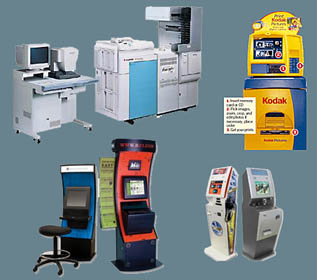

|
| Home • Reviews • Forums • News 2015 • 2013 • 2012 • 2009 • 2008 • 2007 • 2006 • 2005 • 2004 RSS Feeds • FOV Factor Table • Sensor Sizes | Definitions: A-D • E-H • I-L • M-P • Q-U • V-Z | Sitemap Articles • Archived Websites (Pre-DigitalDingus): D100 Lounge • E-10 Club | Contact |
| The $20 Billion Question |
| August 27, 2005 |
| $20 Billion Question (page 1) | $20 Billion Question (page 2)
|
In order to find out why the shift in printing preferences, we again have to look into the recent past. As photographers and hobbyists became aware within a few months of owning their digital cameras, editing and printing photos was not as fun and convenient as they had hoped it to be. Image editing software had to be purchased (the best one being several hundreds of dollars), more hard drive space had to be purchased due to current storage being rapidly used up, but more importantly, personal printing costs were quite expensive. Printers were cheap, but the printing cartridges themselves easily added up to the cost of the printer in only a few months if you were a regular photographer who printed photos. The digital camera owner was beginning to look to other alternatives. Retail Printing Responds In 2002, the digital printing labs were soon replacing the on-site film labs (or at the least, being added to the film labs). Now you could bring your images in on a CD-ROM while shopping for groceries and clothes, and have the retail store print them for you when you were finished by the time you checked out. The return of the 1-hr printing service had returned, and it was digital. Not only was this less expensive (about 1/3 of the cost of home printing), but the convenience was driving factor. If you had a wedding shoot over the weekend, you did the job, got home and edited the best images, burned the images to CD, and skipped and hummed down to your favorite retail printing outlet. A few days later, maybe even a day later, you had your images ready. And they were PERFECT. Why? The retail chain store used Fuji's Frontier printing system for starters. Here you had access to a $250,000+ printer, and you paid less per print than your $150 printer you thought was a great deal. Oh boy, this was great! More photographers needed to know about this! Well, more photographers did. And here we are today with retail printing reaching a 40% share in digital printing services. From the looks of it, this market share will only increase. It is estimated that 8 billion prints will be made just this year alone, and half of them will be from the retail stores. Currently, about 40% of US households have some sort of digital camera. What Will The Future Mean To Digital Photographers? This is probably one of the most important questions. What we do know, is that the digital age is requiring a scale of digital storage beyond expectations. I would guess about 90% of most images are not printed, but are stored locally on a computer, or online with a particular service. Because digital photography is inherently so easy, and the amount of images stored is only limited to the media card capacity you have, the average digital consumer is finding out his hard drive contains mostly images! And add to the fact media cards are at their lowest prices ever due to a stagnation of media purchases in general, and you have a catalyst for larger storage needs. Digital cameras and their file sizes are also increasing very quickly due to new models supporting higher megapixel resolutions. The average digital camera has around 6-8MP these days. A 6MP digital, non-DSLR, is around $300-$400. 8MP cameras are still a little expensive, averaging around $700 and up. However, the camera manufacturers are noticing an increasing amount of consumers having few problems spending more. Some of the questions retailers are currently asking behind closed doors, is:
Another side to retail printing, is the super-fast Photo Kiosk Center. If you don't want to stand in line on the weekend for only a few images, or you only have a particular media card with you, simply use the Kiosk to load the images in the machine, select the assortment of options (which are currently increasing), select payment options, and print the images. Currently 25% of all Kiosks are for printing images. This is a rather large share, considering how many different kiosks there are. And the kiosks are featuring more options as well. Support for Bluetooth is capable on about 87% of the kiosks out there today. More image editing features you would normally see on an advanced image editing program, are also becoming evident as more professional photographers are using them. Better, More Powerful, and Less-Costly Printing The future is very bright for digital photographers. The competition in this market is very fierce, as hundreds of companies want to compete for your printing needs. However, with fierce competition, comes confusion. You will have a lot of options in front of you so be sure to visit several of your local printing outlets and see which one fits your particular printing style. Chances are, you may not be aware of how easy you can make your digital life, and how much money you can save in the process.
Sources:
1) Photo Industry 2005: Review & Forecast (499KB PDF)
|
| Home • Reviews • Forums • News 2015 • 2013 • 2012 • 2009 • 2008 • 2007 • 2006 • 2005 • 2004 RSS Feeds • FOV Factor Table • Sensor Sizes | Definitions: A-D • E-H • I-L • M-P • Q-U • V-Z | Sitemap Articles • Archived Websites (Pre-DigitalDingus): D100 Lounge • E-10 Club | Contact |